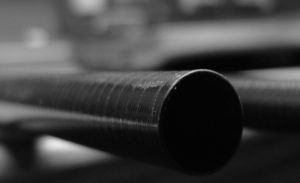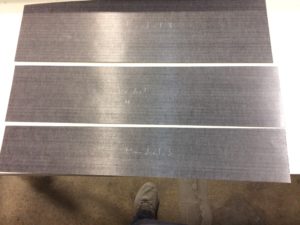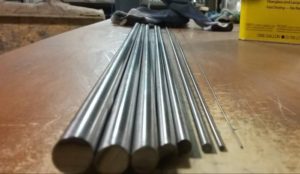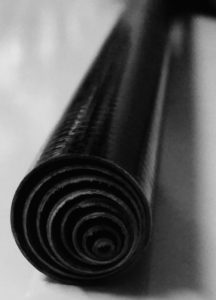 As more tenkara rod companies have popped up in recent years and consumers have greater options, one question is being asked more frequently, but is rarely being answered adequately. “What’s the difference between tenkara rods from different companies if they’re both the same length and flex?” This seems like it should be a relatively easy question to answer, but it’s quite complicated and many rod companies/manufactures don’t even know the differences themselves. The fact is, tenkara rods from different companies, regardless of identical length and flex specs, are most often very different.
As more tenkara rod companies have popped up in recent years and consumers have greater options, one question is being asked more frequently, but is rarely being answered adequately. “What’s the difference between tenkara rods from different companies if they’re both the same length and flex?” This seems like it should be a relatively easy question to answer, but it’s quite complicated and many rod companies/manufactures don’t even know the differences themselves. The fact is, tenkara rods from different companies, regardless of identical length and flex specs, are most often very different.
Fly rods, whether regular rods or tenkara rods, are only as good as their rod blank. It doesn’t matter how they’re packaged or what other bells and whistles come with the rod. In the end, you’re paying for the rod blank – or at least that’s what you should be paying for, not fancy handles, paint jobs or marketing campaigns.
The rod blank is what makes up the main course of your rod. Beyond the obvious measurements of length and flex, a plethora of variables exist that impact your rod’s performance. These include blank taper, diameter, girth, wall thickness, number of sections (which impacts flex, strength, durability and collapsed length), carbon fiber quality, carbon fiber modulus, the number of wraps used to form the rod blank, wrap directionality and whether any resins or composite materials have or have not been used in the making of the blank. All these factors give a rod blank it’s character. Additionally, the dimensions, specs, material and components of the rod handle, along with the finishes used to complete the rod, produce a finished product that will perform in a certain manner, for better or for worse. These variables also determine whether a rod will be strong (have backbone), be brittle and break when under pressure, how it will flex and recover, how sensitive it is or how it transfers information, whether it will feel front heavy or balanced in the hand, how accurately it casts and, how much line it can throw. So, when comparing tenkara rods, there’s much more that impacts a rod’s performance besides length and flex.
Material
The moment you pick up a tenkara rod and give it a wiggle you get feedback or a “sense” of the rod. At that moment what’s talking to you the loudest, is the material, what the rod is made of. Today, most tenkara rods are made from carbon fiber, but not necessarily the same quality or grade of carbon fiber because not all carbon fiber is created equally.
Carbon fiber is a material made up of extremely fine fibers consisting mostly of carbon atoms that are bonded together in crystals that align parallel to the long axis of the fiber. These fibers are then bundled together in quantities ranging on average from 1K to 24K (K= thousands) to make up “tows” or “yarns”. These  different sized tows or yarns can then be woven into different patterns such as unidirectional, twead, braids and several others to make various carbon fiber “fabrics”. Different patterns have different characteristics and qualities based on the pattern itself and the tow size used to create it. The same pattern can be made using different tow sizes and this will change the character and performance of the woven fabric. Variables are almost unlimited.
different sized tows or yarns can then be woven into different patterns such as unidirectional, twead, braids and several others to make various carbon fiber “fabrics”. Different patterns have different characteristics and qualities based on the pattern itself and the tow size used to create it. The same pattern can be made using different tow sizes and this will change the character and performance of the woven fabric. Variables are almost unlimited.
To make life easier, when talking about carbon fiber, it’s defined by grades. Grades are based primarily on two factors, tensile strength and tensile modulus. Tensile Strength (ksi) is a measurement of the maximum stress a material can withstand while being stretched or pulled apart before it breaks or fails under pressure. Tensile Modulus (msi) is a measurement of elasticity or flexibility – how much the material deforms (and returns to its original state) under pressure. Tensile modulus is a ratio of stress to strain. While tensile strength (ksi) and tensile modulus (msi) are correlated, they are different, so don’t confuse stiffness or “elasticity” (tensile modulus) with strength (how much pressure is takes to break it or be pulled apart). Confused yet? If you answered “No” hold tight because there’s more. If you responded “Yes”, just push through it, you’ll get there.
Carbon fiber grades are broken out into four categories based on a range of tensile strength and tensile modulus: Standard Modulus, Intermediate Modulus, High Modulus and Ultra-High Modulus. Keep in mind the higher the modulus, the smaller and denser are the fiber strands used to create it. This results in needing less of a higher modulus carbon fiber material, to obtain the same stiffness as a lower modulus carbon fiber material. However, the manufacturing process to create these higher purity strands is more time consuming and complex, so higher modulus carbon fibers are more expensive. High and Ultra-High Modulus carbon fiber is extremely expensive and primarily used in aerospace applications.
 In the sports industry, Standard and Intermediate Modulus grades are used. Intermediate Modulus (IM) carbon fibers range from a low IM5 to a high IM10 (in China the range is from IM6 to IM12) and are used in making higher-end fly rods and tenkara rods. Interestingly, when you review the tensile strength and tensile modulus within the IM range, there’s not a huge difference in tensile modulus (elasticity) between the different IMs. The range is from 40 to 45 msi. Yet, there’s a considerable difference in the tensile strength (what it takes to break it or cause failure). Intermediate Modulus tensile strengths range from 770 ksi in a low IM5/6, to over 1010 ksi in a high IM10/12. And remember, the higher the carbon fiber grade and IM, the lighter the material will be. These factors, when combined, create the price discrepancy between different Intermediate Modulus carbon fibers and as such, the rod blanks manufactuered from them. How else, besides price, does this lesson in carbon fiber transfer to rod blank performance?
In the sports industry, Standard and Intermediate Modulus grades are used. Intermediate Modulus (IM) carbon fibers range from a low IM5 to a high IM10 (in China the range is from IM6 to IM12) and are used in making higher-end fly rods and tenkara rods. Interestingly, when you review the tensile strength and tensile modulus within the IM range, there’s not a huge difference in tensile modulus (elasticity) between the different IMs. The range is from 40 to 45 msi. Yet, there’s a considerable difference in the tensile strength (what it takes to break it or cause failure). Intermediate Modulus tensile strengths range from 770 ksi in a low IM5/6, to over 1010 ksi in a high IM10/12. And remember, the higher the carbon fiber grade and IM, the lighter the material will be. These factors, when combined, create the price discrepancy between different Intermediate Modulus carbon fibers and as such, the rod blanks manufactuered from them. How else, besides price, does this lesson in carbon fiber transfer to rod blank performance?
Rod blanks made from a lower IM carbon fiber material will be heavier, less sensitive and less accurate than those made from a high IM carbon fiber. They may also be more “elastic” and more durable. A rod blank made from a high IM carbon fiber will be lighter, stronger, more sensitive, more accurate, and more efficient. But it may also be less elastic and less durable. Keep in mind, regardless of the grade or IM of the carbon fiber used to make a blank, a rod can still be designed to have a specific flex. It just may or may not “do the job as well” or have a more limited application due to the inherent characteristics of the material used to produce it. Many of these can be off-set and even heighted, based upon the rod specs that paired with a specific material. But, without question, a tenkara rod made with a rod blank rolled with IM5 carbon fiber will feel very different and perform very different from a tenkara rod with a rod blank made from an IM10 carbon fiber, regardless of whether all other specs are different or the same.
 When it comes to designing or purchasing a tenkara rod, it’s not just about choosing a length and flex. Rod designers and consumers should consider girth, taper, number of sections, wall thickness, wrap directionality, etc. But even more so, they should consider (or at least know) the grade of carbon fiber and its rating within that grade, that they’re using or getting. Because of all things, it’s this, that gives the greatest character to any given rod. It’s the stuff the rod is actually made from, that give it more or less backbone, make it lighter but stronger, give you solid or wet noodle hook-sets, make it dampen quick, be more or less sensitive, and determines much of its casting abilities. Not to sound corny, but it’s what inside, that counts. So, while you may or may not know the IM of your tenkara rod, know there is a difference and whenever possible, do hand-in-hand, side-by-side comparisons and you will definitely feel the difference. Then, as a consumer, you can make your own educated choice on the characteristics and qualities of a tenkara rod that most meet your needs.
When it comes to designing or purchasing a tenkara rod, it’s not just about choosing a length and flex. Rod designers and consumers should consider girth, taper, number of sections, wall thickness, wrap directionality, etc. But even more so, they should consider (or at least know) the grade of carbon fiber and its rating within that grade, that they’re using or getting. Because of all things, it’s this, that gives the greatest character to any given rod. It’s the stuff the rod is actually made from, that give it more or less backbone, make it lighter but stronger, give you solid or wet noodle hook-sets, make it dampen quick, be more or less sensitive, and determines much of its casting abilities. Not to sound corny, but it’s what inside, that counts. So, while you may or may not know the IM of your tenkara rod, know there is a difference and whenever possible, do hand-in-hand, side-by-side comparisons and you will definitely feel the difference. Then, as a consumer, you can make your own educated choice on the characteristics and qualities of a tenkara rod that most meet your needs.




Karen, this is all great information for your current and future patrons.
I understand and measure these same values selecting the best tonewood I can find for designing and building custom musical instruments for my clients. Those instruments have great volume, but more importantly they have enhanced tonal bandwidth, more sustain, respond to a light touch, as well as being driven with intensity. I suspect it is the same with your rods.
Most luthiers don’t know and couldn’t care less about what a Modulus of Elasticity is, Janka Harness, and how they make a guitar work. They just copy what has traditionally been done before. Sound familiar?
You are spot on for educating yourself about all of this and using it to define greater rods. Bravo!
Mark
http://www.roberts-guitars.com
Pingback: What is a FRAE Rating | Zen Tenkara